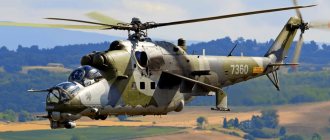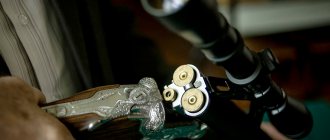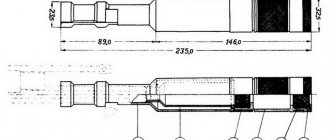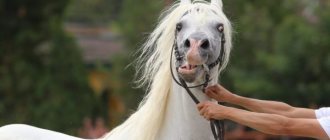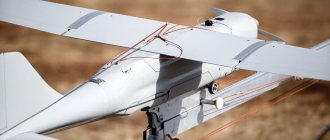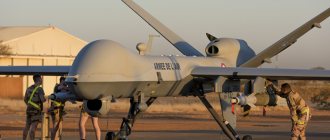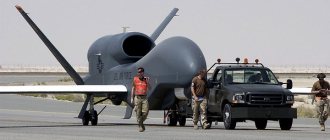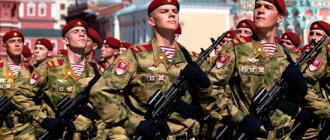Nowadays, many developing countries allocate a lot of money from their budgets to improve and develop new types of UAVs - unmanned aerial vehicles. In the theater of military operations, it was not uncommon for the command to give preference to a digital machine over a pilot when solving a combat or training mission. And there were a number of good reasons for this. Firstly, it is continuity of work. Drones are capable of performing a task for up to 24 hours without interruption for rest and sleep - integral elements of human needs. Secondly, it's endurance.
The drone operates almost uninterruptedly in conditions of high overloads, and where the human body is simply not able to withstand overloads of 9G, the drone can continue to operate. Well, thirdly, this is the absence of the human factor and the execution of the task according to the program embedded in the computer complex. The only person who can make a mistake is the operator who enters the information for the mission - robots do not make mistakes.
Introduction
In this section you will find all the comprehensive information about the legislation of the Russian Federation affecting the operation of unmanned aerial vehicles/unmanned aerial vehicles (hereinafter referred to as UAVs/UAVs/UAVs) with a maximum take-off weight from 0.25 kilograms to 30 kilograms, as well as about the registration process itself, obtaining permission to fly, and punishment for ignoring the law on registration and rules for using the airspace of the Russian Federation. All information provided in this section will be periodically updated as the law affecting the unmanned hobby is formed.
Problems to be solved
Can be classified into four main groups:
- emergency detection;
- participation in emergency response;
- search and rescue of victims;
- disaster damage assessment.
In such tasks, the senior operator must optimally select the route, speed and altitude of the UAV flight in order to cover the observation area in the minimum time or number of flights, taking into account the viewing sectors of television and thermal imaging cameras.
In this case, it is necessary to exclude double or multiple flights of the same places in order to save material and human resources.
Additional material is available by clicking the “Download” button after the article
Abbreviation
Abbreviation used in this section:
- UAV is an unmanned aircraft (same as BGVS/UAV/UAV).
- BGVS is an unmanned civil aircraft.
- UAV (UAV) - unmanned aerial vehicle.
- VS - aircraft (UAVs, airplanes, helicopters of civil and military aviation).
- VP - airspace.
- IVP - use of airspace.
- EU ATM of the Russian Federation - Unified air traffic management system of the Russian Federation.
- The EU ATM GC is the main center of the Unified Air Traffic Management System.
- EU ATM LCs are zonal centers of the Unified Air Traffic Management System.
- EC ATM RCs are regional centers of the Unified Air Traffic Management System.
- MR - local mode.
- VR - temporary mode.
- FAVT - Federal Air Transport Agency.
Some terminology
UAV, UAV, UAV, Drone, Unmanned aerial vehicle
: all these names and abbreviations refer to aircraft capable of operating autonomously (without a crew in the cockpit).
Such devices fly independently according to flight instructions; there is no need to control them directly. The flight is carried out by a built-in flight controller
(autopilot).
UAV operators
or, as they are also called, “remote pilots” are specialists who operate such equipment.
They fly drones using Ground Control Stations
(GCS).
Even the most advanced drone cannot operate without ground equipment. And when we say “buy a drone,” we always mean buying an entire unmanned aircraft system
(ALS), which includes everything you need.
Decree of the Government of the Russian Federation
Decree of the Government of the Russian Federation dated May 25, 2019 No. 658 “On approval of the Rules for accounting for unmanned civil aircraft with a maximum take-off weight from 0.25 kilograms to 30 kilograms imported into the Russian Federation or produced in the Russian Federation.” Effective date: September 27, 2019.
Quote: “Clause 2 of the Rules. Application for registration of an unmanned aircraft, provided for in paragraph 8 of the Rules approved by this resolution, in relation to an unmanned civil aircraft with a maximum take-off weight from 0.25 kilograms to 30 kilograms, imported into the Russian Federation or produced in the Russian Federation before the date of entry into force of this resolution is sent by the owner of such an aircraft to the Federal Air Transport Agency within a period not exceeding 30 days from the date of entry into force of this resolution.”
Let's summarize: Each owner of a drone with a maximum take-off weight from 0.25 kilograms to 30 kilograms must register it by submitting an application to the Federal Air Transport Agency (hereinafter referred to as FAVT).
Types of unmanned aerial vehicles
The 90s were marked by the widespread introduction of new communication and navigation systems, in particular GPS. This became the basis for the emergence of a new type of UAV, the management and acquisition of data from which was significantly simplified. As a result, their creation went beyond military projects and a young civilian market for these aircraft was formed. Experts regularly predict unprecedented growth, but time shows that some prophecies are still too optimistic. However, in 2016, 2.8 million civilian models were sold in the US alone, with total industry sales of $953 million.
The active development of drones and their introduction into the civilian environment have led to an increase in options for their use:
- Passenger transportation - for example, in Dubai, at an international summit, a model of an unmanned taxi Ehang 184 was demonstrated, which can be in the air for about 30 minutes in one flight. Essentially, this is a single-seat eight-rotor quadcopter, which is devoid of any controls, i.e. in fact, a person flies in this device as a passenger, not a pilot. The small cabin contains a chair and a touch screen tablet, using which you can specify your destination. In 2022, Airbus' Vahana air taxi made its first test flight. In February of the same year, the secret air taxi Joby Aviation was reported; the project startup had already raised $100 million.
- Economic activity - drones take on certain aviation functions: conducting aerial photography or other types of data collection needed for agriculture, monitoring situations on the roads and in any remote areas. With their help, they track the migration routes of animals, find lost ships, identify the level of hydrometeorological danger, and conduct inspections of power lines.
- Entertainment/sports shows - such devices are most often equipped with main rotors and are like helicopters rather than airplanes. This design is the most rational because it does not require a runway. The recreational use of UAVs has recently expanded with air racing. Most often, self-assembled models or substantially redesigned ready-made ones are used for them. As a result, they are able to reach speeds above 150 km/h, but are classified as devices with small dimensions. It should be noted that the startup Alauda Racing has launched a fundraiser on the Kickstarter platform for the world’s first manned multicopter races, which are planned for 2022.
- Professional or amateur photography - all modern models are equipped with a high-quality camera and allow you to take amazing pictures in places where a person could never reach on their own.
- Freight transport - In 2016, Amazon tested package delivery using a quadcopter and applied for technology to deliver cargo using a parachute. In recent months, news has been actively appearing with concepts of large cargo drones capable of moving at high speeds and carrying up to several tons. Like, for example, Sabrewing Aircraft's Draco-2 model and Boeing's test assembly.
- Military UAVs - drones were originally created for the needs of the army. This is an excellent reconnaissance tool for collecting data on the position of enemy forces, dropping ammunition, firing at specified targets, and not only air models, but also underwater ones.
Russian underwater model “Status-6”
Deadlines for submitting an application for registering a UAV
Quote: “Clause 12 of the Rules. An application for registration of an unmanned aircraft is submitted to the Federal Air Transport Agency within the following deadlines:
- in case of purchasing an unmanned aircraft on the territory of the Russian Federation - within 10 working days from the date of acquisition;
- in case of import of an unmanned aircraft into the Russian Federation - within 10 working days from the date of import;
- in the case of self-manufacturing of an unmanned aircraft - before the start of its use for flights in the airspace above the territory of the Russian Federation, as well as beyond its borders, where responsibility for organizing air traffic is assigned to the Russian Federation.”
Show at the Olympic Games in South Korea
The opening ceremony of the Olympics took place in South Korea, in which the famous Shooting Star quadcopters from Intel took part in the amount of 1218 pieces and set a new world record, previously held by the Chinese Ehang, better known for its Ehang 184 taxi. The history of this record is quite dramatic. The Intel team, with coverage befitting the scale of the event, expanded its unmanned group, increasing the number of flying and glowing quadcopters by a hundred or two, until an impressive figure of 500 pieces was reached. And then, out of nowhere, these Chinese appeared and, like confident players, doubled down: during last year's Chinese New Year, they launched 1000 Ehang Ghost 2.0 models at once. The next record was quietly set by them in the first half of December 2022 and amounted to 1180 pieces. Two months passed and the brave guys, under the command of an equally brave girl, set a new record with broadcast to the whole world.
The procedure for accounting for UAVs
Quote: “Clause 8 of the Rules. To register an unmanned aircraft, the owner of the unmanned aircraft submits to the Federal Air Transport Agency an application for registration of the unmanned aircraft, accompanied by a photograph of this unmanned aircraft, containing the following information:
a) Information about the unmanned aircraft and its technical characteristics:
- Unmanned aircraft type (manufacturer's assigned name)
- Serial (identification) number of the unmanned aircraft (if available)
- Number of engines installed on an unmanned aircraft and their type (electric engine, gas turbine engine, internal combustion engine)
- Maximum take-off weight of an unmanned aircraft
b) Information about the manufacturer of the unmanned aircraft:
- Name (for legal entity)
- Last name, first name, patronymic (for an individual entrepreneur or individual who independently manufactured an unmanned aircraft)
c) Information about the owner of the unmanned aircraft:
- Telephone (fax) number, email address;
- Full name, main state registration number, taxpayer identification number, address (for a legal entity)
- Last name, first name, patronymic, main state registration number of the state registration record of an individual entrepreneur, taxpayer identification number, residence address (for an individual entrepreneur)
- Last name, first name, patronymic, date and place of birth, insurance number of an individual personal account, number, series and date of issue of an identity document, address of residence (for an individual who is not an individual entrepreneur).”
Examples of mass use of drones
Military attack in Khmeimim
On the night of January 6, 2022, UAVs attacked Russian units in Syria, thus the first combat use of a swarm of drones was recorded for the first time. The harsh Syrian oppositionists moved from experiments to practice, choosing the Russian Khmeimim airbase and the naval support point in Tartus as targets. A group of 13 pieces was quite suitable for training electronic warfare and anti-aircraft gunners. 7 units were shot down by the Pantsir-S1 complex, and the remaining 6 were planted. Upon contact with the ground, 3 UAVs exploded. A study of the remaining ones showed that the launch was made from the Idlib de-escalation zone. To do this, the drones had to cover more than 50 kilometers.
In the most popular photo published, the terrorist drone standing on a table really looks like a makeshift model. But several points are noteworthy: battery capabilities and control distance (remember the distance of 50 km before the attack), payload weight (in the photo below you can see the number of bombs on each wing) and mass use. Today, any artisanal workshop is able to establish small-scale production of drones and, with the help of a small engineering team, turn them into a serious problem. That is why concerns about the development of this technology are so actively discussed and the creation of weapons to destroy UAVs continues.
How to submit an application?
There are several ways to submit an application to the FAVT:
- On your own or through a courier service
- Mailing
- State Services Portal
- UAV accounting portal
Upon completion of the registration process, the drone will be assigned a registration number.
Quote: “Clause 28 of the Rules. The registration number of an unmanned aircraft, assigned in the manner established by these Rules, must be applied to the structural elements of the unmanned aircraft before it begins flights.”
Let's summarize: After providing the above information about the registered drone to the Federal Air Transport Agency, in one of the available ways, the device will be assigned an account number, which will have to be on board the UAV for the duration of the flights.
Application form
Applications for registration of UAVs:
- Application for registration of UAV (for an individual who is not an individual entrepreneur).
- Application for registration of UAV (for a legal entity).
- Application for registration of UAV (for an individual entrepreneur).
Recommendation requirements for UAV photos.
The photograph of the UAV must be in color on a light, plain background. The size of the UAV shown in the photo must occupy at least 70% of the total size of the image and contain an image of all structural elements of the UAV. The shooting angle should provide a display of the entire visible area of the UAV, allowing for its identification.
Use of UAVs for civilian purposes
Drones have found their calling not only on the battlefield or during military operations. Now drones are actively used for completely peaceful purposes by citizens in urban environments, and even in some branches of agriculture they have found use.
Thus, some courier services use helicopter-powered robots to deliver a wide variety of goods to their customers. Many photographers use drones to take aerial photographs when organizing special events.
Some detective agencies also adopted them.
Rules for using VP
According to the Federal Rules for the use of airspace of the Russian Federation: “If there is a need for the use of airspace at the same time by 2 or more airspace users, a prohibition or restriction of their activities in certain areas of the airspace of the Russian Federation is established in accordance with state priorities in the use of airspace, carried out by introducing temporary (VR) and local modes (LR), as well as short-term restrictions.”
Temporary mode
Quote: Clause 137 of the RF IVP: “The temporary regime is established by the main center of the Unified System to ensure the following types of activities:
f) carrying out flights of unmanned aerial vehicles in the airspace of classes
And
».
Local mode
Quote: “Clause 137 of the RF IVP of the Russian Federation: The local regime is established by the zonal center of the Unified System in the lower airspace to ensure the following types of activities:
d) flying an unmanned aerial vehicle in airspace of classes C and
».
Quote: Clause 139 of the RF IVP: “Local regime on air routes and local air lines open for international flights, as well as in the areas of airfields open for international flights, is not established.”
Structure of the EU ATM of the Russian Federation
Structure of EU ATM Centers of the Russian Federation
What you should pay attention to?
Even drones of the same design and power plant can differ significantly from each other. Before purchasing a product, you must decide what kind of work the device will perform - a thorough flight over small areas or long-term monitoring. Once you answer this question, you can consider other metrics.
Flight duration
This indicator affects the distance the drone can travel without refueling or replacing batteries. During area surveys, during which the UAV flies on tacks, the length of the route determines how much area it can cover. This way you can determine the cost effectiveness of its operation.
Please note that the maximum flight duration is tested under optimal conditions (no wind, no precipitation, average air temperature of about +20°C). In most cases, the operating time is indicated without taking into account the payload mass. Accordingly, after its installation, the flight duration may change significantly, not for the better.
Payload and versatility
Modern unmanned aircraft are designed with multi-tasking in mind. The same drone can be used for aerial photography, video monitoring, cargo delivery and other tasks. To ensure this, the aircraft becomes a universal carrier of various equipment.
But this is only relevant if such a UAV is equipped with the necessary equipment for all use cases at once. Most often, unmanned vehicles are developed in such a way that the electronic equipment (avionics) consists of separate modules that are mounted as needed. So, if you plan to use the drone only as a camera carrier, then there is no need to install expensive radio links on it to broadcast video. The modular system allows for more flexible pricing of products depending on the requirements of the end user.
Any configuration of the Albatross UAV can be modified by installing such modules even after the start of operation, if during the work new tasks arise that need to be solved by our clients.
Some drones are designed to solve a specific task. But even within its framework they can have universality. For example, Agrodrone for agriculture is not intended for video surveillance and aerial photography. It is designed to perform agricultural operations. But even within the framework of this specialization, he can apply liquid and granular fertilizers, plant protection products, generate fog, and sow seeds.
For the multifunctional Albatross UAVs, many payloads have been developed to obtain the necessary information: video cameras, cameras, magnetometers, thermal imagers, laser scanners, gas analyzers.
When choosing a payload, as when choosing the UAV itself, the purpose of using the equipment plays an important role. For example, if you need information for land surveying or topographical work, then this requires a camera with a large matrix and accurate geodetic receivers. If you need to take inventory of your space, then basic drone equipment will provide the necessary accuracy, and you can save a lot of money.
Reliability and portability
Every buyer is looking for a reliable and portable drone. These indicators depend on the material used to make the UAV and its design.
Reliability, for the most part, depends on the materials from which the UAV and its components are made. To achieve reliability, designers find a balance between the mass of the structure and its strength. This allows the device to maintain operating condition, despite external influences, throughout its entire service life. Our company uses high-quality materials to manufacture devices. The body of the Albatross UAV is made of strong and durable composites: fiberglass and carbon.
To ensure portability, drones are dismountable and transported in convenient containers or cases. At the same time, they take up minimal space during transportation and storage, and are brought into flight condition by the operator without much effort in a short time.
Launch and landing method
Small aircraft-style UAVs are usually launched manually or using a launcher. The launching device can be an elastic catapult, a mechanical launching device or a pneumatic system. The elastic catapult operates like a slingshot. It is fixed to the ground with a drill on one side, and on the other, the operator manually pulls the device and then releases it. This method is universal, and the catapult itself is easy to use and does not take up much space. Mechanical and pneumatic catapults relieve the operator of the physical burden of launching the device and simplify the takeoff of the UAV, but they require constant maintenance and are large in size.
Takeoff of the Albatross UAV using an elastic catapult
Unmanned aircraft also land in different ways. The smallest products in terms of weight and dimensions sometimes have the ability to fit directly onto the body. But mostly landing is carried out by parachute. Depending on the design, UAVs land directly on the body or are equipped with special inflatable cushions.
Unmanned aircraft land using a parachute and, to preserve their payload, touch the ground in an inverted position so that the pressure body takes the brunt of the load.
Helicopter-type UAVs, as well as vertical take-off and landing aircraft, use small, flat, hard-surfaced areas for launch and landing. Depending on the device, these operations occur either fully automatically or with the participation of an operator.
terms of Use
Weather conditions can greatly affect the performance of a drone. When purchasing a UAV, you need to check what maximum loads the device is designed for (wind force, air temperature). There are also restrictions on the takeoff of UAVs. However, it is worth remembering that even with light precipitation or low clouds, which do not affect the flight performance of the UAV, you may receive data of unsatisfactory quality and your flight will be useless.
Ground control station
The capabilities of the aircraft will depend on the functionality of the ground control station (GCS). It should be equipped with convenient tools for creating a flight mission and managing payloads. It should also provide convenient control over all parameters during the flight.
Using the GCS, the user adjusts the drone's speed and flight direction, sets the desired shooting altitude, sets the landing point, and controls the payload. Some NSU models are equipped with a screen onto which video images are transmitted in real time.
Software
It’s not enough just to take a photo, the operator must be able to work with the received data. To do this you will need specialized software. Such software must be able to interpret the received data and display it in the format you need. For example, to obtain an orthomosaic, you will need a program that can orthorectify images, combining them into a single whole, and then assign the resulting area to coordinates.
To find out what programs you will need for data processing, you can contact our specialists. In addition, it provides services for processing and presenting data obtained during the work.
Obtaining permission for temporary residence permit
Temporary mode
A brief procedure for obtaining permission for a temporary residence permit is a temporary regime.
To obtain permission you must:
- Obtain permission for UAV flights from the local government (if the flights will be carried out within the boundaries of populated areas).
- Coordinate UAV flights with a military airfield (if flights will be carried out in the area of responsibility of a military airfield).
- Primary coordination of UAV flights with the EC ATM RC, obtaining information about the conditions for conducting UAV flights.
- Drawing up a submission to establish a temporary regime, sending it and agreeing with the head of the EC ATM RC.
- Sending and approval of a submission for establishing VR to the EU ATM CC.
- Sending and approval of a submission for the establishment of VR to the EU ATM MC (contacts; fax; telephone;).
- Obtaining a temporary mode number (GC EC ATM +7 (495) 601-06-64).
- Submitting the UAV flight plan to the EU ATM Center no less than 24 hours before the start of the event.
- At least 2 hours before the start of the event, inform the period of your activity to the official of the military airfield with whom the flights were previously agreed upon (if the flights will be carried out in the area of responsibility of the military airfield)
- At least 2 hours before the start of the event, inform the period of your activity (confirm that you will use the mode set for you or cancel it if you change your mind about flying) to the EC ATM EC and EC ATM RC.
- At least 1 hour before the start of the event, request permission to use the airspace from the EU ATM RC.
- Notify no later than five minutes after the planned start of the activity: about the actual start time of the activity; about delay, postponement or cancellation of activities in the EU ATM RC.
- Report the actual start time of the activity to the official of the military airfield with which the flights were previously coordinated.
- Notify no later than ten minutes after the end of the activity: about the actual end of the activity; about breaks in aerodrome flights for more than an hour at the EC ATM RC.
- Report the actual time of completion of the activity to the official of the military airfield with whom the flights were previously coordinated (if the flights were carried out in the area of responsibility of the military airfield).
- Report the actual end time of activities to the EU ATM Main Center and remove the temporary regime (in the event that UAV flights will not be carried out).
Local mode
A brief procedure for obtaining permission for a temporary residence permit - local regime.
To obtain permission you must:
- Availability of permission for UAV flights from the local government (if the flights will be carried out within the boundaries of populated areas).
- Coordinate UAV flights with a military airfield (if flights will be carried out in the areas of responsibility of a military airfield).
- Initially, coordinate UAV flights with the EC ATM RC, obtain information about the conditions for conducting UAV flights.
- Draw up submissions for the establishment of a local regime, send and coordinate it with the head of the EC ATM RC.
- Send and agree on submissions for the establishment of MR to the EU ATM CC.
- Obtain a local regime number from the EU ATM Center.
- Send the UAV flight plan to the EU ATM Center at least 24 hours before the start of the event.
- At least 2 hours before the start of the event, inform the official of the military airfield with whom the flights were previously agreed upon (if the flights will be carried out in the area of responsibility of the military airfield).
- At least 2 hours before the start of the event, inform the period of your activity (confirm that you will use the mode set for you or remove it if you change your mind about flying) to the EC ATM EC and EC ATM RC.
- At least 1 hour before the start of the event, request permission to use the airspace from the EU ATM RC.
- Notify no later than five minutes after the planned start of the activity: about the actual start time of the activity; about delay, postponement or cancellation of activities in the EU ATM RC.
- Report the actual start time of the activity to the official of the military airfield with whom the flights were previously coordinated (if the flights will be carried out in the area of responsibility of the military airfield).
- Notify no later than ten minutes after the end of the activity: about the actual end of the activity; about breaks in aerodrome flights for more than an hour at the EC ATM RC.
- Report the actual time of completion of the activity to the official of the military airfield with whom the flights were previously coordinated (if the flights were carried out in the area of responsibility of the military airfield).
- Report the actual end time of the activity to the EU ATM control center and remove the local mode (in the event that UAV flights will not be carried out).
If the dispatcher of the EC ATM RC, when providing information about the conditions for UAV flights, informed that the flights will be carried out under the conditions of establishing a local regime, then there is no need to agree on the document and coordinate the flights with the Main EC ATM Center.
Step-by-step instructions for obtaining permission to fly a drone using the example of the Kaliningrad region.
To summarize: According to the current rules for the use of the airspace of the Russian Federation, in order to implement the flight of any aircraft (controlled by a pilot directly from the cockpit or remotely from the ground; with a maximum take-off weight of 0.25 kilograms), it is necessary to carry out a number of mandatory actions and approvals both with local authorities and and with the operational bodies of the Unified Air Traffic Management System. On the one hand, such a multi-stage approach guarantees the safe movement of aircraft, on the other hand, it seriously complicates the use of civilian UAVs in the interests of the unmanned hobby, which caused massive dissatisfaction among the entire R/C community of the Russian Federation, and in general influenced officials to review the existing rules of airborne aircraft and introduce them into them relaxing amendments (see section below).
Foreign drones
One of the directions in the development of UAVs is to reduce their dimensions without significant damage to technical characteristics. The Norwegian company has developed a helicopter-type micro drone PD-100 Black Hornet.
This drone can operate for about a quarter of an hour at a distance of up to 1 km. This robot is used as a soldier's personal reconnaissance device and is equipped with three video cameras. Used by some US regular units in Afghanistan since 2012.
| TTX Black Hornet | |
| Length | 100 mm. |
| Weight | 120 gr. |
| Range of flight | 1000 m. |
| Working hours | 25 min. |
| Equipment | 3 optical video cameras with a resolution of 3 MP |
The most common U.S. Army drone is the RQ-11 Raven. It is launched from the soldier’s hand and does not require a special platform for landing; it can fly both automatically and under operator control.
US soldiers use this lightweight drone to solve short-range reconnaissance missions at the company level.
| TTX RQ-11 Raven | |
| Length, mm | 790 |
| Weight, gr. | 1800 |
| Wingspan, m | 1.5 |
| Flight range, km | up to 5 |
| Power point | Electric motor |
| Operating time, min | 45…60 |
| Equipment | day vision digital video camera, night vision camera |
Heavier UAVs of the American army are represented by the RQ-7 Shadow and RQ-5 Hunter. Both samples are intended for reconnaissance of terrain at the brigade level.
The continuous operating time in the air of these drones differs significantly from lighter models. There are numerous modifications of them, some of which include the function of hanging small guided bombs weighing up to 5.4 kg on them.
MKyu-1 Predator is the most famous American drone. Initially, its main task, like many other models, was terrain reconnaissance. But soon, in 2000, manufacturers made a number of modifications to its design, allowing it to carry out combat missions related to the direct destruction of targets.
In addition to suspended missiles (Hellfire-S, created specifically for this drone in 2001), three video cameras, an infrared system and its own on-board radar are installed on board the robot. Now there are several modifications of the MKyu-1 Predator to perform tasks of a wide variety of nature.
In 2007, another attack UAV appeared—the American MKew-9 Reaper. Compared to the MKyu-1 Predator, its flight duration was much higher, and in addition to missiles, it could carry guided bombs on board and had more modern radio electronics.
| Type of UAV | MKyu-1 Predator | MKew-9 Reaper |
| Length, m | 8.5 | 11 |
| Speed, km/h | up to 215 | up to 400 |
| Weight, kg | 1030 | 4800 |
| Wingspan, m | 15 | 20 |
| Flight range, km | 750 | 5900 |
| Power plant, engine | piston | turboprop |
| Operating time, h | up to 40 | 16-28 |
| Missile/bomb load | up to 4 Hellfire-S missiles | bombs up to 1700 kg |
| Service ceiling, km | 7.9 | 15 |
The RQ-4 Global Hawk is rightfully considered the largest UAV in the world. In 1998, it took off for the first time and to this day carries out reconnaissance missions.
This drone is the first robot in history that can use US airspace and air corridors without permission from air traffic control.
| TTX RKyu-4 Global Hawk | |
| Length, m | 13.3 |
| Wingspan, m | 35 |
| Flight range, km | 22 000 |
| Weight, t | 15 |
| Power point | Turbofan engine |
| Equipment | IR system, reconnaissance complex, radar complex |
| Operating time, h | 36 |
| Service ceiling, km | 18 |
Flight without approval
According to Decree of the Government of the Russian Federation dated 02/03/2020 No. 74 “On Amendments to the Federal Rules for the Use of the Airspace of the Russian Federation” (clause 52.1), obtaining permission to use airspace is not required if the following conditions are met:
- Max. UAV take-off weight up to 30 kg.
- The flight is carried out within line of sight.
- The flight takes place during daylight hours.
- The flight takes place at an altitude of less than 150 meters from the earth or water surface.
- The flight is carried out outside the control zones of civil aviation aerodromes, areas of aerodromes (heliports) of state and experimental aviation, prohibited zones, flight restriction zones, special zones, airspace above places of public events, official sports competitions, as well as security measures carried out in accordance with Federal Law “On State Protection”. (to get acquainted with such zones, use the Internet resource: fpln.ru via
). - The flight is carried out at a distance of at least 5 km from control points of uncontrolled airfields and landing sites.
How did household drones appear?
As the history of the emergence and development of drones shows, for a long time these drones were used by people purely for military purposes. However, UAVs gradually began to be used in various sectors of the national economy and for scientific research.
But consumer, or household, drones, in particular quadcopters, which are so popular today, appeared at the turn of the twentieth and twenty-first centuries thanks to fans of radio-controlled flying models. At this time, smartphones were already widely used in everyday life, and amateur designers realized that these gadgets had everything they needed for an autopiloted and remotely controlled vehicle. Mobile phones have become cheaper and more convenient for their parts to be used in drones. In addition, the necessary components began to appear on the market (if there is demand, there will be supply).
What smartphone parts are useful for household drones:
– gyroscope. This small sensor makes the drone go where you tell it to go in the form of a contactless command;
– accelerometer. Another mobile sensor that helps the drone maintain altitude, determine the direction and speed of movement;
– microcomputer. A processor that makes the drone more and more “smart” and advanced every year. By the way, modern manufacturers produce them for both mobile phones and UAVs;
– GPS navigator, which helps to navigate in space not only to a person, but also to a drone;
- camcorder. The prestige (and therefore the price) of both the smartphone and the drone depends on its quality.
It is worth noting that drones produced by reputable companies, even when they acquired a commercial purpose, were at first very expensive and required experienced specialists to operate and maintain them. Therefore, no one could have imagined that these devices would soon become available to the average consumer. However, in 2010, the startup company Parrot demonstrated an AR Drone, a quadcopter controlled using an iPod or iPhone smartphone and equipped with two video cameras. This was a real breakthrough in the consumer drone industry, thanks to which soon (since 2013) numerous drones of various designs and prices appeared on the world market.
It was then that quadcopters became the most popular household UAVs, and the world leader in the production of consumer drones was the Chinese company DJI, which still holds the lead in this area.
It has many competitors (say, GoPro or 3D Robotics), but they are significantly inferior to the Chinese manufacturer in all respects. And the pioneer in the production of household quadcopters, the Parrot company, completely abandoned this idea. Today, only Yuneec is a worthy competitor to DJI.
As American analysts predict, the number of household drones sold in 2020 will reach almost 5 million; of which, at least 20 percent will come from Russian consumers. As we can see, the market for small UAVs is growing rapidly, despite the fact that the main obstacle to its growth remains the imperfection of federal and global laws on the use of drones.
Responsibility
The remote pilot is responsible for preventing collisions between drones and manned aircraft and other objects in the air, as well as collisions with obstacles on the ground.
Punishment
Federal Law No. 217-FZ of July 26, 2019 “On Amendments to the Code of the Russian Federation on Administrative Offenses” toughens penalties for violating the rules for the use of airspace.
Punishment for violating the rules for the use of airspace (Administrative Code of the Russian Federation Article 11.4.):
- Violation by a user of airspace of federal rules for the use of airspace, if this action does not contain a criminal offense, shall entail the imposition of an administrative fine on citizens in the amount of twenty thousand to fifty thousand rubles; for officials - from one hundred thousand to one hundred fifty thousand rubles; for legal entities - from two hundred fifty thousand to three hundred thousand rubles or administrative suspension of activities for a period of up to ninety days.
- Violation of the rules for the use of airspace by persons not duly authorized to carry out activities in the use of airspace, if this action does not contain a criminal offense, shall entail the imposition of an administrative fine on citizens in the amount of thirty thousand to fifty thousand rubles; for officials - from fifty thousand to one hundred thousand rubles; for legal entities - from three hundred thousand to five hundred thousand rubles or administrative suspension of activities for a period of up to ninety days.
Powers of Law Enforcement
On December 2, 2022, the President of the Russian Federation signed Federal Law No. 404-FZ dated December 2, 2019 “On Amendments to Certain Legislative Acts of the Russian Federation,” improving the regulation of the use of unmanned aircraft and clarifying the powers of law enforcement agencies in this matter. According to the law, the right to temporarily restrict the presence of unmanned aircraft in the airspace above the venue of a public (mass) event and the adjacent territory, as well as to suppress the unauthorized presence of unmanned aircraft in the airspace, including through the destruction and damage of such aircraft, suppression or transformation remote control signals in order to protect the life, health and property of citizens, carry out urgent investigative actions, operational investigative and anti-terrorist measures will be available to the following agencies: the Ministry of Internal Affairs, the Federal Penitentiary Service, the Russian Guard, the FSB, the Foreign Intelligence Service and the Federal Security Service. Nevertheless, the actions of these services must be carefully worked out and regulated, which will clarify: the procedure for making a decision to suppress the illegal use of UAVs, as well as the list of officials authorized to make such a decision. In this regard, on December 5, 2022, a round table was held in the State Duma to discuss the powers of law enforcement agencies to suppress the illegal use of drones using electronic or even physical influence with small arms, where a number of problems were identified that will have to be faced in the process of forming such regulations.
Domestic UAVs
Russian drones are conventionally divided into the following categories
| Short range | Up to 25 km |
| Short range | From 50 to 100 km |
| Medium range | From 100 to 500 km |
| Long range | Over 500 km |
The Eleon-ZSV UAV is a short-range device, it is quite simple to operate and can be easily carried in a backpack. The drone is launched manually from a harness or compressed air from a pump.
Capable of conducting reconnaissance and transmitting information via a digital video channel at a distance of up to 25 km. Eleon-10V is similar in design and operating rules to the previous device. Their main difference is the increase in flight range to 50 km.
The landing process of these UAVs is carried out using special parachutes, ejected when the drone exhausts its battery charge.
| Type of UAV | Eleon-3SV | Eleon-10V |
| Length, mm | 740 | 1150 |
| Weight, kg | 4.3 | 5.9 |
| Speed, km/h | 70…100 | 75…135 |
| Flight range, km | 25 | 50 |
| Operating time, h | 1.5…2 | 2.5 |
| Service ceiling, km | 5 | 5 |
Reis-D (Tu-243) is a reconnaissance and strike drone capable of carrying aircraft weapons weighing up to 1 ton. The device, produced by the Tupolev Design Bureau, made its first flight in 1987.
Since then, the drone has undergone numerous improvements; an improved flight and navigation system, new radar reconnaissance devices, and a competitive optical system have been installed.
Irkut-200 is more of an attack drone. And it primarily values the high autonomy of the device and its low weight, thanks to which flights lasting up to 12 hours can be carried out. The UAV lands on a specially equipped platform about 250 m long.
| Type of UAV | Reis-D (Tu-243) | Irkut-200 |
| Length, m | 8.3 | 4.5 |
| Weight, kg | 1400 | 200 |
| Power point | turbojet engine | ICE with a capacity of 60 hp. With. |
| Speed, km/h | 940 | 210 |
| Flight range, km | 360 | 200 |
| Operating time, h | 8 | 12 |
| Service ceiling, km | 5 | 5 |
Skat is a new generation heavy long-range UAV being developed by the MiG Design Bureau. This drone will be invisible to enemy radars, thanks to the body assembly design that eliminates the tail.
The task of this drone is to carry out precise missile and bomb attacks on ground targets, such as anti-aircraft batteries of air defense forces or stationary command posts. According to the developers of the UAV, Skat will be able to perform tasks both autonomously and as part of an aircraft flight.
| Length, m | 10,25 |
| Speed, km/h | 900 |
| Weight, t | 10 |
| Wingspan, m | 11,5 |
| Flight range, km | 4000 |
| Power point | Double-circuit turbojet engine |
| Operating time, h | 36 |
| Missile/bomb load | Adjustable bombs 250 and 500 kg. |
| Service ceiling, km | 12 |
